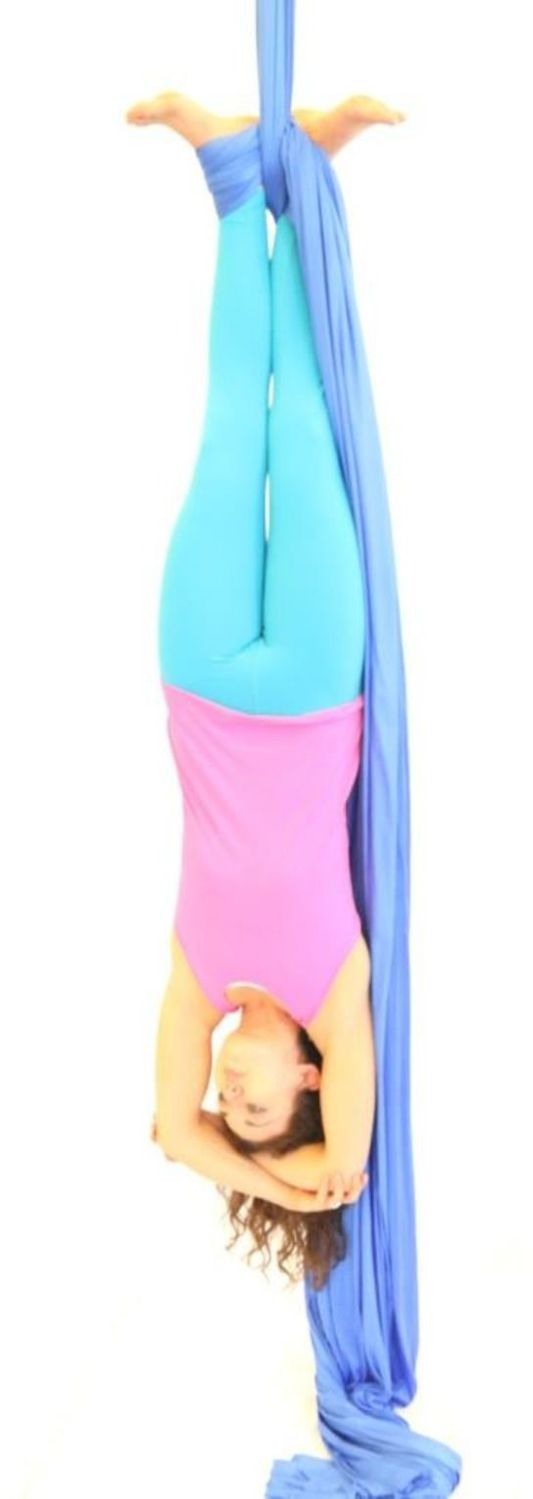
 Beginners Guide to Aerial SilkCopyright 2014 by Jill Franklin All rights reserved. No part of this book may be reproduced, or transmitted in any form or by any means, without the prior written permission of Jill Franklin. ISBN: 978-0-692-28823-8 Please Note:
Beginners Guide to Aerial SilkCopyright 2014 by Jill Franklin All rights reserved. No part of this book may be reproduced, or transmitted in any form or by any means, without the prior written permission of Jill Franklin. ISBN: 978-0-692-28823-8 Please Note:
This book has been written and published strictly for informational purposes, and in no way should it be used as a substitute for live instruction with a professional. DEDICATION I dedicate this book to my incredible parents, who have always given me the freedom to follow my passions. Also, to my wonderful husband whos confidence in me and our team spirit has helped me accomplish this book. Many thanks to all of my aerial and Pilates clients over the years who have believed in me as a teacher.
You are the reason for this book, I truly appreciate you! Table of Contents PREFACE Dear Aspiring Aerialist, My romance with aerial began many years ago when I saw my first Cirque du Soleil show at the age of fourteen. I was mesmerized by the beauty, grace and strength the performers displayed. At the time I assumed one would have to grow up in a circus school, spending hours a day training away to achieve such skill. I only had a background in ballet and did not possess the skill set to duplicate what I had admired on stage. Little did I know then, that years later I would be performing similar aerial feats in front of thousands of people in beautiful theaters throughout the world. When I first began aerial in my early 20s in New York City, I was terrible.
I lacked the upper body strength and coordination. With consistent practice, patience and belief in myself, I eventually overcame my limits with strength and achieved my skill on a professional level. I have a passion for helping others and feel the same romance that I do with aerial. My background in ballet, classical Pilates and yoga all encompass my Aerial Physique technique. The key to any worthwhile fitness endeavor is strength, flexibility and cardiovascular activity. Aerial work has it all! The best part about it, its incredibly rewarding and fun! The book I have designed is for the beginner who would like to deepen their understanding of aerial silk work.
It is not intended as the sole learning avenue. It is best to always practice with a qualified instructor. I wish for you to be patient, consistent and kind to yourself while learning. Enjoy, be safe and most of all have fun! 
 INTRODUCTION What is aerial silk? Aerial silk (aka: fabric, tissu, ribbons) is a beautiful art form and evolving fitness craze. Practitioners of this strength building craft climb, invert and wrap their bodies into and out of various positions stemming from gymnastics and ballet. It can also be referred to as aerial acrobatics, aerial dance or aerial fitness.
INTRODUCTION What is aerial silk? Aerial silk (aka: fabric, tissu, ribbons) is a beautiful art form and evolving fitness craze. Practitioners of this strength building craft climb, invert and wrap their bodies into and out of various positions stemming from gymnastics and ballet. It can also be referred to as aerial acrobatics, aerial dance or aerial fitness.
Aerial acrobatics has been seen in the circus for thousands of years. The modern world began to take note of this stunning art form in 1998 when Cirque du Soleils show Quidam displayed an aerial silk contortion act on red fabric. Since then, many circus schools, dance companies and most recently fitness studios and gyms have been offering classes in aerial silk. This book introduces you to the fundamental skills, positions and movements involved in aerial silk work. The aerial movement principles are inspired by the Pilates Method principles. It also gives you an at home guide to strengthen your upper body and core when not at aerial class.
The positions and movements demonstrated in this book are shown on the right side, it is important to do them on the left also. I have come across many different names for the movements and positions in this book, you may have learned them as another name. Feel free to call them what youd like, aerial is constantly evolving. The ascent into artistry demonstrated within, are building blocks for more advanced variations and combinations. Take your time learning the basics thoroughly, with clean technique and proper form. It is much more impressive to do the feats smooth and controlled, versus throwing yourself into things too soon and potentially getting injured or tangled in the fabric! Keep an eye out for future books from Aerial Physique.
Visit the Aerial Physique You Tube Channel for instructional videos with Jill Franklin. For more information visit the Aerial Physique website at www.aerialphysique.com. USE THIS BOOK AT YOUR OWN RISK Aerial work is a dangerous activity that can lead to serious injury or death. The use of this book and contents therein, is at your own risk. Beginners Guide to Aerial Silk by Jill Franklin is intended for use as a tool of reference for those who are taking aerial classes with a professional instructor. AERIAL FOUNDATION  Aerial Movement Principles 1.
Aerial Movement Principles 1.
Safety: Aerial is a potentially dangerous activity that can cause injury or even death. Make sure that you are suspended on an apparatus that has been installed by a licensed rigger and always practice with a professional instructor. Know you limits. If you find you are tired stop and rest. It is best to be safe then push yourself too far. 2.
Concentration: The key element to connecting your mind and body is concentration. Aerial work is both a physical and mental practice. It is extremely important to be present in your mind while learning and executing movements. You will progress much more rapidly while having a safer approach to the task at hand. 3. Precision: Practice makes perfect.
Proper form is essential to ensure you achieve the beautiful lines of the positions while preventing injury. 4. Control: In aerial work, control of your entire body is the name of the game. No sloppy or haphazard movements are allowed. 5. 6. 6.
Breathing: Controlling your breath with deep exhalations as you perform aerial movements helps activate your muscles and keep you focused. When you are upside down it is very easy to forget to breath! 7. Balance: A truly balanced body has an equal amount of strength and flexibility. Muscles should be supple, mobile, yet strong. Flexibility and range of motion are important components in aerial work. 8.
Flow: In time aerial work becomes continuous flowing movement. An aerial dance. Each movement, position and transition should be smooth and graceful. In the beginning movements may feel awkward and jerky, allow yourself plenty of practice and soon you will be flowing with ease! Aerial Terminology Aerial: Performed in the air. Arabesque: A ballet position made by balancing on the supporting leg, while extending the free leg behind with a straight knee. Carabiner: A metal loop with a spring-loaded gate used in rigging aerial apparatus. Crochet: A term used in aerial silk work when wrapping your arms or legs from the outside around the fabric and securing the position using your hand or foot.
Next page

















 Beginners Guide to Aerial SilkCopyright 2014 by Jill Franklin All rights reserved. No part of this book may be reproduced, or transmitted in any form or by any means, without the prior written permission of Jill Franklin. ISBN: 978-0-692-28823-8 Please Note:
Beginners Guide to Aerial SilkCopyright 2014 by Jill Franklin All rights reserved. No part of this book may be reproduced, or transmitted in any form or by any means, without the prior written permission of Jill Franklin. ISBN: 978-0-692-28823-8 Please Note:
 INTRODUCTION What is aerial silk? Aerial silk (aka: fabric, tissu, ribbons) is a beautiful art form and evolving fitness craze. Practitioners of this strength building craft climb, invert and wrap their bodies into and out of various positions stemming from gymnastics and ballet. It can also be referred to as aerial acrobatics, aerial dance or aerial fitness.
INTRODUCTION What is aerial silk? Aerial silk (aka: fabric, tissu, ribbons) is a beautiful art form and evolving fitness craze. Practitioners of this strength building craft climb, invert and wrap their bodies into and out of various positions stemming from gymnastics and ballet. It can also be referred to as aerial acrobatics, aerial dance or aerial fitness. Aerial Movement Principles 1.
Aerial Movement Principles 1.